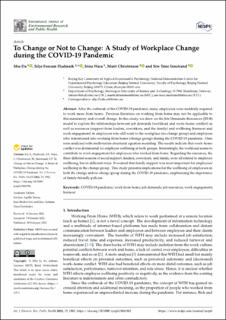| dc.contributor.author | Da, Shu | |
| dc.contributor.author | Wara, Irina | |
| dc.contributor.author | Christensen, Marit | |
| dc.contributor.author | Innstrand, Siw Tone | |
| dc.date.accessioned | 2022-03-16T10:21:54Z | |
| dc.date.available | 2022-03-16T10:21:54Z | |
| dc.date.created | 2022-02-16T09:51:44Z | |
| dc.date.issued | 2022 | |
| dc.identifier.issn | 1661-7827 | |
| dc.identifier.uri | https://hdl.handle.net/11250/2985461 | |
| dc.description.abstract | After the outbreak of the COVID-19 pandemic, many employees were suddenly required to work more from home. Previous literature on working from home may not be applicable to this mandatory and overall change. In this study, we drew on the Job Demands–Resources (JD-R) model to explore the relationships between job demands (workload and work–home conflict) as well as resources (support from leaders, coworkers, and the family) and wellbeing (burnout and work engagement) in employees who still went to the workplace (no-change group) and employees who transitioned into working from home (change group) during the COVID-19 pandemic. Data were analyzed with multivariate structural equation modeling. The results indicate that work–home conflict was detrimental for employee wellbeing in both groups. Interestingly, the workload seems to contribute to work engagement for employees who worked from home. Regarding the resources, the three different sources of social support, leaders, coworkers, and family, were all related to employee wellbeing, but in different ways. It seemed that family support was most important for employees’ wellbeing in the change group. This study presents implications for the wellbeing of employees in both the change and no-change group during the COVID-19 pandemic, emphasizing the importance of family-friendly policies. | en_US |
| dc.language.iso | eng | en_US |
| dc.publisher | MDPI | en_US |
| dc.rights | Navngivelse 4.0 Internasjonal | * |
| dc.rights.uri | http://creativecommons.org/licenses/by/4.0/deed.no | * |
| dc.subject | Hjemmekontor | en_US |
| dc.subject | Home Office | en_US |
| dc.subject | Koronapandemi | en_US |
| dc.subject | coronary pandemic | en_US |
| dc.subject | Jobbengasjement | en_US |
| dc.subject | Job engagement | en_US |
| dc.subject | Utbrenthet | en_US |
| dc.subject | Burnout | en_US |
| dc.title | To Change or Not to Change: A Study of Workplace Change during the COVID-19 Pandemic | en_US |
| dc.type | Journal article | en_US |
| dc.type | Peer reviewed | en_US |
| dc.description.version | publishedVersion | en_US |
| dc.subject.nsi | VDP::Organisasjonspsykologi: 268 | en_US |
| dc.subject.nsi | VDP::Organisational psychology: 268 | en_US |
| dc.source.journal | International Journal of Environmental Research and Public Health (IJERPH) | en_US |
| dc.identifier.doi | 10.3390/ijerph19041982 | |
| dc.identifier.cristin | 2002151 | |
| cristin.ispublished | true | |
| cristin.fulltext | postprint | |
| cristin.qualitycode | 1 | |

